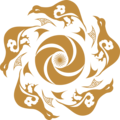At that time, it contained 4,000 artifacts acquired by Andrzej Wawrzyniak during his nine years of diplomatic service in Indonesia. This kind of private collection was unusual in terms of its value and scope. For the period of diplomatic service in Vietnam, Indonesia, Laos, Nepal and Afghanistan, Andrzej Wawrzyniak visited almost all countries of Asia, Australia and most of Oceania, but it was Indonesia that became his main source of inspiration. It is for this reason that the first name of the museum was the "Museum of the Nusantara Archipelago" -after the Malay name for the region where the collection itself originated. On January 1, 1976, the museum received a new name: "Museum of Asia and the Pacific in Warsaw", which, of course, was due to the fact that objects from other regions besides Indonesia began to be purchased for the collection.
In 2017, the name of Andriy Wawrzyniak, its founder and first director, who held this position for 40 years (until 2013), was added to the name of the museum.
Currently, the museum stores more than 23,000 objects originating from almost every country on the Asian continent and many states of Oceania. In addition to the founder's Indonesian collection, the collection includes weapons, textiles, numerous theatrical puppets and masks, musical instruments, sculptures and paintings by 20th-century artists from Mongolia, India, Nepal, Tibet, Vietnam, Burma, Laos, China, Afghanistan, Papua New Guinea and Vanuatu. Some of the items were added to the collection thanks to numerous donations.
More information about this can be found in the book-album "Cultural Legacy of Uzbekistan in the Museums of Poland" (volume XL) from the series "Cultural Legacy of Uzbekistan in the Collections of the World".
The general sponsor of the project is the oilfield service company Eriell-Group.
